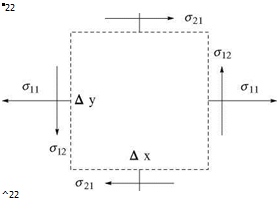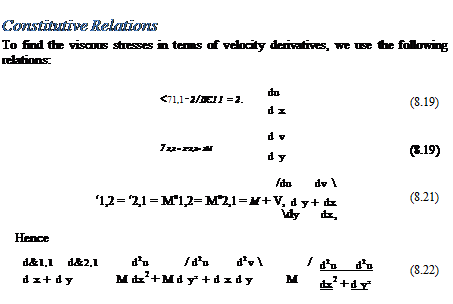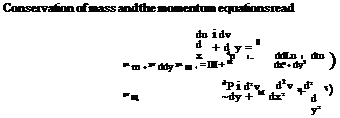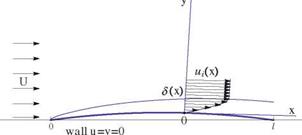Viscous Stresses in 2-D (Cartesian Coordinates)
To account for viscous stresses in the momentum equations, consider an element as in the sketch, Fig. 8.4.
The viscous forces in the x-direction are
( Ax Ax
&1,1(x + —, y, t) – ah1(x – —, y, t) Ay
( Ay Ax
+ 02,1 (x, y + -2-, t) – <72,1 (x, y – —, t) Ax (8.13)
Dividing by Ax. Ay and taking the limit gives
д71,1 до2,1
dx + dy
Fig. 8.4 Viscous stresses in 2- D
 |
Similarly, the viscous forces in the y-direction is
Ax Ax
01,2 (x + —, y, t) – 0-1,2(x – —, y, t) Ay
![]() ( Ay Ax
( Ay Ax
+ 02,2(X, y + —, t) – 02,2(X, y – —, t) Ax
Again, dividing by Ax. Ay and taking the limit gives
|
|
Note: taking moments about the centroid (x, y)
![]() 0 = ^ M = o1,2Ax. Ay – ff2,iAx. Ay
0 = ^ M = o1,2Ax. Ay – ff2,iAx. Ay
hence 01,2 = 02,1.
The momentum equations for viscous fluid flow become:
![]() dp. do1,1 , do2,1 dx + dx + dy d p. d01,2 , do2,2 dy + + ~dy~
dp. do1,1 , do2,1 dx + dx + dy d p. d01,2 , do2,2 dy + + ~dy~
 |
|
 |
|
|
|
|
|
|
|
|
|
|
|
 |
![]()
|
Fig. 8.5 Boundary layer development on a thin airfoil |
The boundary conditions for the flow past a profile or a plate are the following (Fig.8.5):
• on the solid surface, no penetration, no slip,
• in the far field, no disturbance.












